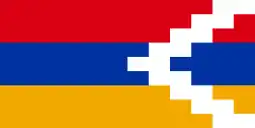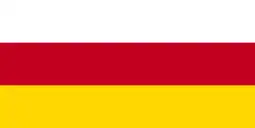Community for Democracy and Rights of Nations
The Community for Democracy and Rights of Nations (Russian: Сообщество за демократию и права народов), also commonly and colloquially known as the Commonwealth of Unrecognized States,[1] rarely as CIS-2 (Содружество непризнанных государств, СНГ-2), is an international organization in Eastern Europe and Western Asia of four breakaway states in the territory of the former Soviet Union, all of which have limited to no recognition from the international community.
 Map of Eastern Europe and the Caucasus with the member states of the Community for Democracy and Rights of Nations (red) | |
| Formation | 14 June 2006 |
|---|---|
| Type | Political cooperation organization |
| Location | |
Membership |
|
History

An agreement on creating the commonwealth was reached by the four separatist states of Abkhazia, South Ossetia, Transnistria and Artsakh in 2001 at the foreign ministers meeting held in Stepanakert,[2] the capital of Artsakh. The Community for Democracy and Human Rights was established on 14 June 2006 in Sukhumi, Abkhazia, by the presidents of three of these states: Sergei Bagapsh representing Abkhazia, Eduard Kokoity representing South Ossetia and Igor Smirnov representing Transnistria.[3] Artsakh, which had been part of the 2001 agreement, left in 2004 but became a member in 2007. All four member states have limited international recognition: Abkhazia and South Ossetia are in the internationally recognized territory of Georgia,[4][5] Transnistria in Moldova[6] and Artsakh in Azerbaijan.[7] All of them are secured by the presence of Russian military forces.
On 17 June 2007, the four-state Community for Democracy and Peoples' Rights signed in Tiraspol—the capital of Transnistria—the joint Declaration on principles of peaceful and fair settlement of the Georgian–Abkhazian, Georgian–Ossetian, Azeri–Artsakh and Moldovan–Transnistrian conflicts. It calls for barring all types of pressure, such as military deployments, diplomatic isolation, economic blockades, or information wars, during negotiations toward resolution of conflicts. It also calls for external guarantees to eventual political settlements of these conflicts.[8]
On 27 September 2009 three members of the Community for Democracy and Peoples' Rights (all but Artsakh) agreed to abolish the visa regimes for their citizens. The agreement came into effect one month after its ratification by all three parliaments. It lasted for five years, after which it was automatically extended for another five-year term.[9]
As of 2017, the four member states have a combined population of 947,480 people. Abkhazia and South Ossetia have secured recognition from United Nations member states such as Venezuela, Nicaragua, Nauru, Russia and Syria,[10] as well as the Sahrawi Republic. Meanwhile, political leaders of Abkhazia, South Ossetia, and Transnistria have all promised to integrate their economies and perhaps seek membership in the Russian-led Eurasian Union.[11]
Members
 Abkhazia
Abkhazia Artsakh (until 31 December 2023)
Artsakh (until 31 December 2023) South Ossetia
South Ossetia.svg.png.webp) Transnistria
Transnistria
Administrative centres
See also
- Commonwealth of Independent States
- Community of Democratic Choice
- Community of Democracies
- Eastern Partnership
- Eurasian Economic Union
- Euronest Parliamentary Assembly
- European integration
- Foreign relations of Artsakh
- GUAM Organization for Democracy and Economic Development
- List of active separatist movements in Europe
- Politics of Europe
- Regions of Europe
- Self-determination
- South Caucasus
- Unrepresented Nations and Peoples Organization
References
- "Transnistrian Time-Slip" by Frank Jacobs, New York Times May 22, 2012
- "Бум суверенитетов Archived 2008-10-13 at the Wayback Machine" – 2007-01-23, retrieved 2008-08-31
- Community for democracy and people's rights. Accessed: August 27, 2008. Archived from the original on August 7, 2008.
- Kvarchelia, L. (1998). Georgia-Abkhazia conflict: view from Abkhazia. Demokratizatsiya, 6(1), 18-27.
- "The Law of Georgia on Occupied Territories (431-IIs)" (PDF). State Ministry for Reintegration. 23 October 2008. Archived from the original (PDF) on 24 June 2014. Retrieved 1 February 2015.
- Roper, Steven D (1 September 2001). "Regionalism in Moldova: The Case of Transnistria and Gagauzia". Regional & Federal Studies. 11 (3): 101–122. doi:10.1080/714004699. ISSN 1359-7566.
- Ghaplanyan, V. (2021). Armenia and Azerbaijan: High risk of cross-border violence in Nagorno-Karabakh despite ceasefire. Armed Conflict Location & Event Data Project,(24-26).
- Official website of the Community for Democracy and People’s Right’s
- Южная Осетия, Абхазия и Приднестровье договорились упразднить между собой визовый режим (in Russian). Caucasian Knot. 27 September 2009. Archived from the original on 18 May 2015. Retrieved 3 October 2009.
- "BREAKING NEWS: Syria recognizes South Ossetia and Abkhazia, armenpress.am 29 May 2018.
- "Alexandru Leşanu: Transnistria’s presidential election: A hard-fought contest with no punches pulled, as Russia diverts its attention from the unrecognised state, blogs.lse.ac.uk 23 December 2016.